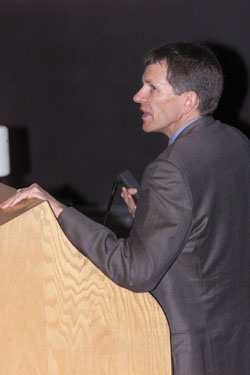
Dr. Evan C. Unger was one of the guest speakers at the forum.
Drug delivery focus of Pharmacology forum
New ways to get drugs into the body were the focus of this year’s Joel G. Hardman Student-Invited Pharmacology Forum. Speakers at the afternoon symposium presented possibilities ranging from ultrasound-activated “microbubbles” to bioengineered polymers that release insulin in response to blood sugar levels. The forum’s topic was “Novel Approaches to Drug Delivery.”
Dr. Evan C. Unger, president and CEO of ImaRx Therapeutics, Inc., began the symposium with a presentation titled “Drug and Gene Delivery Using Ultrasound and Acoustically Active Carriers.”
Unger has pioneered the development of microbubbles – gas bubbles coated with a layer of fat molecules. He showed that microbubbles act as a contrast agent and improve the diagnostic capabilities of ultrasound. The tiny spheres also can be directed to specific cells or tissues by attaching targeting molecules to the bubble coating.
Focused ultrasound waves cause the microbubbles to burst, creating a local shock wave that can break holes in cell membranes, Unger said. He and his colleagues have used targeted microbubbles to detect and break apart blood vessel clots.
“The microbubbles bind to the clot and light it up like a light bulb,” Unger said. “Relatively low levels of directed ultrasound energy can then be used to achieve therapeutic clot lysis.”
Unger suggested that the microbubbles might be useful for targeted delivery of chemotherapeutic drugs to tumor tissues and for gene delivery.
Joseph Kost, D.Sc., professor of Chemical Engineering at Ben-Gurion University in Israel and chief scientific officer of Sontra Medical, discussed ultrasound approaches and novel biomaterials in his seminar “Intelligent Drug Delivery Systems.”
“Intelligent” systems, he said, would optimally deliver drugs in response to physiological needs. Patients with diabetes, for example, would benefit from a system that delivers insulin in response to changing blood sugar levels.
Kost described two different possibilities for insulin delivery. One was an ultrasound-modulated transdermal (across the skin) approach. He and colleagues have demonstrated that a brief ultrasound pulse to the skin opens pores that allow more ready detection of substances in the body and passage of drugs through the skin. They have already conducted clinical trials of the method as a blood sugar detection system.
“This non-invasive, safe approach is accurate at assessing blood sugar levels 90 percent of the time. The FDA requires 95 percent accuracy, so we’re not there yet, but we’re working on it,” Kost said. The possibility exists, he said, to couple transdermal blood sugar detection with insulin delivery.
In another approach, Kost and colleagues have studied a polymer matrix embedded with insulin and enzyme proteins. The enzymes act on blood glucose, generating products that cause the polymer matrix to swell and release insulin. Kost said the approach could someday be applied to bioengineered microspheres, which might need to be injected only once per month.
Dr. Clifford J. Steer, professor of Medicine, Genetics, and Cell Biology at the University of Minnesota, switched gears and talked about gene therapy during his presentation “Non-viral Gene Repair/Therapy.”
Traditional gene therapy approaches – often using viruses as delivery agents – suffer from delivery problems, random integration of the introduced gene into a cell’s DNA, and unregulated gene expression, Steer said. His group has moved in a different direction to develop technologies for gene repair.
When a single defective gene causes a disease, the problem is often with one letter of the genetic code, Steer said. “In the best case scenario, we would develop a technology that can find that single mutation and trick the cell into correcting it.”
Steer and colleagues have successfully developed such a technology, using pieces of DNA and RNA they call “chimeraplasts.” They have demonstrated that chimeraplasts can correct – in cells from dogs – a mutation that causes hemophilia B. They have also corrected the mutation underlying a rare genetic disorder called Crigler-Najjar syndrome in a rat model of the disease.
Children with Crigler-Najjar have extreme jaundice because they lack an enzyme that processes bilirubin. They have two treatment options – 12-18 hours per day under blue lights or a liver transplant. Steer and colleagues hope to conduct a clinical trial of the gene repair therapy in Crigler-Najjar patients.
“Numerous single gene diseases are going to be excellent candidates for gene repair,” Steer said.
The annual student-organized pharmacology forum honors Joel G. Hardman, Ph.D., professor of Pharmacology Emeritus. Hardman was chair of the department of Pharmacology from 1975-1990, and he served as associate vice chancellor for Health Affairs until his retirement in 1997.
“The students named the forum in honor of Dr. Hardman in appreciation for both his scientific contributions to the field of pharmacology and for his recognized talents as an educator and mentor,” said Ronald B. Emeson, Ph.D., Joel G. Hardman Professor of Pharmacology.
Prior to the symposium presentations, Brian E. Wadzinski, Ph.D., assistant professor of Pharmacology and Cell Biology, received the 2001 Teaching Award in Pharmacology.
“Dr. Wadzinski has the unique ability to treat students as equals. He values what students have to say both in the classroom and out of the classroom,” said Michelle Mazei, one of the Pharmacology graduate students presenting the award to Wadzinski.
The student organizers of this year’s forum were Michael Burleigh, Michael Christensen, Leigh Compton, and Scott Ramsey.













